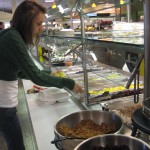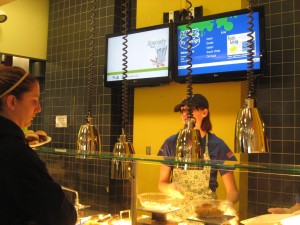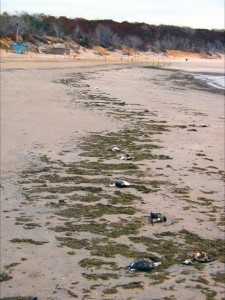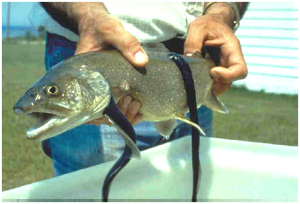 The annual growth of the billion-dollar organic food industry is reaching college and university campuses. However, there is only a pinch of organic food on Bowling Green State University’s campus.
The annual growth of the billion-dollar organic food industry is reaching college and university campuses. However, there is only a pinch of organic food on Bowling Green State University’s campus.
Bowling Green students have a very limited range of organic products to choose on campus. At university food stores, such as Outtakes, the only organic products include small organic pizza, milk, cereals and dried cherries. In the dinning areas the same products are available, however serving organic food to students is something that BGSU dinning services is still working on.
BGSU Dining Director, Micheal Paulus said the university’s organic offerings are limited, mostly due to the cost of product.
“Most students are resistant to the increased price point of pure organic offerings,” he said.
Organic products can be very pricey. The high cost has a lot to do with the practices of organic farming and government regulations. Organic farmers have to take extra precautions due to USDA regulations by the National Organic Program. However, as many people are aware of the high costs of organic food they are rarely aware of the difference in taste.
Bowling Green sophomore, Eric Smuda, a bio engineering major, has put the idea of there being little taste difference to his list of reasons to not buy organic food. “Spending extra money on organic food, when it tastes just like any other regularly grown food, just doesn’t seem necessary to me,” Smuda said.
And he may have a point. If taste difference is the only thing that Bowling Green students are looking forward to getting out of organic food, then they may be in for a heap of disappointment. The International Food Information Council Foundation (IFIC) is a nonpartisan foundation that works to effectively educate the public with its science-based information about nutrition, health and food safety. According to the 2007 Food & Health Survey, published by the (IFIC), when Americans were asked what had the greatest impact on the food they select, taste was ranked the highest (88 percent). Price was ranked second (72 percent).
Over the last few years, there hasn’t been conclusive evidence that organic food is more nutritious than conventionally grown food. The USDA couldn’t even claim organic food is safer or more nutritious. Besides recent results of there being higher levels of Vitamin C in organic strawberries, there isn’t too much for evidence for consumers to depend on in this area.
more nutritious than conventionally grown food. The USDA couldn’t even claim organic food is safer or more nutritious. Besides recent results of there being higher levels of Vitamin C in organic strawberries, there isn’t too much for evidence for consumers to depend on in this area.
With a scarce amount of organic food available on campus, it puts students in a position to spend even more money. Every student living on campus is required to have a meal plan, at least $1,475 per semester. But what about students who want organic food? Living on campus, they could use their meal plans and sacrifice their organic diets or go to a local grocery, buy organic produce then be left with about a thousand dollars worth of meal plan by the end of the semester that just goes to waste.
Amanda McGuire Rzicnek, an instructor for Bowling Green’s General Studies Writing Program, has focused classes on the study of food products, including organic foods. As an organic produce consumer herself, Rzicnek understands how hard it can be eating organic foods. Everyday she brings her organic lunch to campus with her, knowing that she will not be able to go home and eat. However, things are not quiet as simple for students living on campus.
“It’s horrible because they are paying for the meal plan, so why would they go to Meijer to buy organic food? And organic food, most of the time, is a lot more expensive than buying regular food. So they are in a catch 22,” said Rzicnek.
A catch 22 is definitely something sophomore, Lin-Z Kay Tello is in. Tello has the option of getting organic foods from local groceries such as Meijer and Kroger. However, along with the extra money she would have to spend, the trip alone can be inconvenient for students.
“It’s kind of hard to get to some of those places because I have to go out and get my car just to get to the store and then can’t use the meal plan, so its kind of a hassle right now,” explained Tello.
Tello was a student in Rznicnek’s class her freshman year. In the class she researched and wrote about organic foods, and she eventually became an environmental science major. “That class changed my life,” she said. “It just really got me thinking about the impact I have on the environment through my eating habits.”
As much as Tello wants to be an advocate consumer of organic foods, living on campus has made it hard for her to do so.
“I’ve basically kind of put it off until I’m older and live off campus and I’ll be able to go to supermarkets and actually purchase organic foods,” Tello said.
The struggle to find organic food on campus is something that Bowling Green senior, Lindsay Conway can relate to.
“Living off-campus makes a really big difference,” she said. “When on campus, it’s unfortunate, but it’s like you can’t even really have an organic diet. Lets just say if you do, you’ll probably starve.”
Recently Bowling Green’s dining service has made changes to its menus in the dining halls and mini markets to be more nutritional, however, maybe its time for the university to start making larger strides towards providing organic for their students. USA Today reported on a project called the Yale Sustainable Food Project, which is embracing the organic life of Yale students. For the last eight years, the project encourages students and school staff to visit farms to see how the food is grown in an ecologically friendly manner. Yale’s dining service makes organic food available as well. Yale is not the only university following the organic trend on its campus. There is also Williams College, the University of Pennsylvania, and Rutgers University, just to name a few.
BGSU’s dining services does plan to make steps towards providing a little more organic on campus.
“Dining services does plan to increase organic offerings next year with the inclusion of Pinkberry frozen yogurt within the new Commons dinning center,” Paulus said.
Pinkberry frozen yogurt is a healthy of frozen yogurt with a few choices of organic toppings. However, the frozen yogurt is not organic.
Dinning Services plans to feature more “local” produce thru its continued development of relationship with local growers. Dinning services first step in this direction was with its first annual on-campus Farmers market.
Many students were present at the on-campus Farmers market. Bowling Green senior, Lindsey Conway was present. “The market was a wonderful idea, especially the fact that they made things even more convenient for students by accepting their BG1 cards,” she said. “That was great.”
Having an annual farmers market may be one of the best steps to making sure the campus provides more organic opportunities for on campus students. But to keep such organic lifestyles happening on campus. Rizicnek knows there is one thing that must happen.
“The only people that can solve this is Dining Services and I think the only way for that to happen is for students to say what it is that they want, cause they are ultimately paying BG to provide a service,” says Rzicnek.
Thinking of Going Organic?
Places Where You Can Find Organic on Campus: Outtakes at Founders, Kreisher and Offenhauer. Products Include: organic milk, cereal, frozen foods and dry cherries.
Spend your food dollars wisely. BGSU’s Diabetic’s Program presented a list of foods with the highest levels of toxin residues. They advice for people to purchase organic versions of these foods when possible.
- Peaches, Nectarines & Apricots
- Apples & Pears
- Bell Peppers
- Celery
- Strawberries
- Cherries
- Imported Grapes
- Spinach & Lettuce
- Potatoes & Carrots
- Milk & Beef
- Peanut Butter
- Baby Food
















